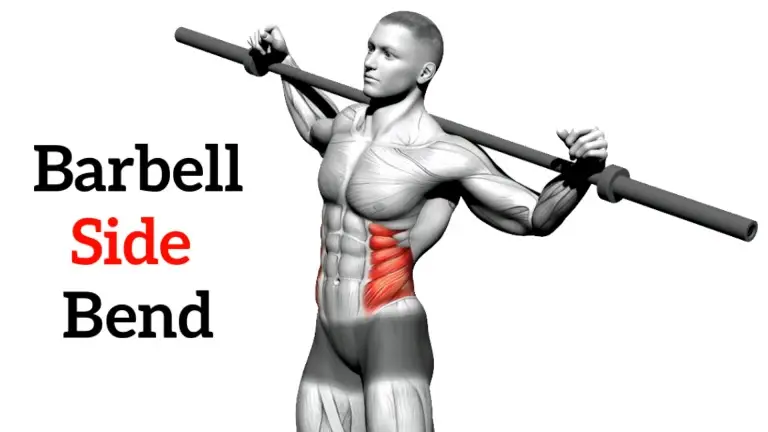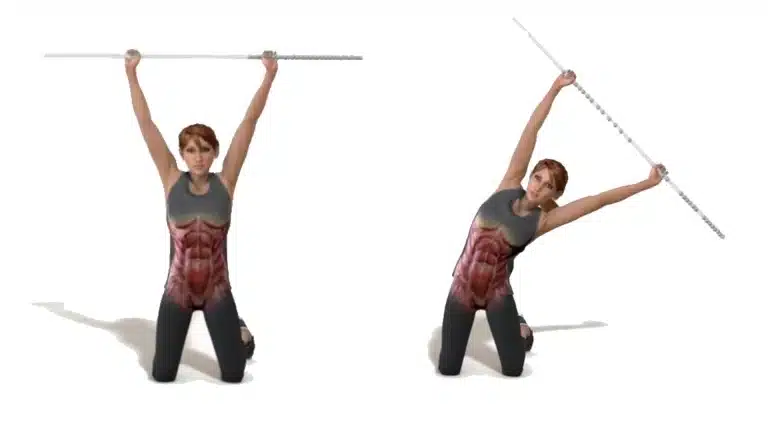Barbell side bends free weight and isolation exercises that work for muscle groups on the side of your body—specifically, the oblique muscles—and also target the lower back.
When done with the right form and technique, it improves the spine’s lateral flexion and functional mobility.
Side bends stretch the abdominal muscles and digestive organs, aiding and regulating digestion, elimination, and metabolism.
For an easier variation, you can do a bodyweight side bend; for the other challenging side bend, use a dumbbell or cable machine.
Variations: You can also do this exercise while standing, sitting on a bench or kneeling.
Try Our Free Calculator To Know Your Body Fat Percentage

Barbell Side Bend Muscles Worked
- Primary Muscles: Obliques (internal and external)
- Secondary Muscles: Rectus abdominis, Erector spinae
- Stabilizing Muscles: Transverse abdominis, Serratus anterior, Quadratus lumborum, Deltoids (when holding the barbell overhead), and Glutes (for balance and stability)
How To Do Standing Barbell Side Bend
- Trust me, this exercise doesn’t need heavy weight to be effective. So begin with an unloaded or light barbell, and as you progress, you can add weight.
- Stand tall, feet shoulder-width apart, and hold the barbell across your upper back, similar to the bar position for a back squat. Make sure it’s resting comfortably without straining your neck or shoulders.
- Tighten your abs before you move. This will protect your spine and ensure you’re working the right muscles.
- Slowly bend to one side by hinging from your waist, lowering your torso as far as your flexibility allows.
- You’ll feel a stretch in your obliques on the opposite side of the bend. Don’t go too far – about 4-6 inches is usually enough. Going too deep can put unnecessary stress on your spine.
- Pause momentarily at the bottom, then use your obliques to pull your torso back to the starting position. Move slowly to ensure control and avoid momentum from taking over.
- Switch to the other after completing reps on one side to ensure balanced development.
Proper Form And Tips
- This isn’t a speed exercise. Move slowly to really feel the oblique stretch and contraction.
- Your head, neck, and back should stay in line as you bend. Imagine sliding your torso between two walls to keep the motion strictly lateral without leaning forward or backward.
- Don’t bend too far. A slight bend is often enough to feel it in your obliques.
- Avoid loading the heavyweight for this exercise. Large, overdeveloped oblique muscles will make your waist appear bulky.
- Avoid letting your hips shift or twist — the movement should come entirely from your obliques.
- Only your waist should move during this exercise.
- Repeat for 3-4 sets of 12 to 15 repetitions.
- You can do many variations of the barbell side bend with a dumbbell, kettlebell, or cable. You can sit on a flat bench instead of standing to perform the variations.
Use our free calorie calculator to determine how many calories you need to eat for healthy weight loss.
Overhead Barbell Side Bend
When you’re holding the barbell overhead, you can generally bend further to the side than with a back-loaded barbell. This means a greater stretch and contraction of those obliques.
During this your shoulders, upper back, and arms work overtime to keep that bar stable overhead. It is like getting a bonus upper body workout while targeting your core.
You can try out many different overhead side bend variations that may require different types of equipment (e.g., dumbbell, resistance band, kettlebell) or even no equipment at all.

Kneeling Overhead Barbell Side Bend
Kneeling overhead side bend stretches the oblique, arms, shoulders and the psoas muscles.
By kneeling, you’re taking your hip flexors out of the equation. This forces your obliques and other core muscles to do all the heavy lifting, literally. The kneeling position can actually be easier on your lower back for some people

If you’ve got bored with barbell side bends or are simply not enjoying them any more, you can try the following barbell side bends alternative exercises

Manish is a NASM-certified fitness and nutrition coach with over 10 years of experience in weight lifting and fat loss fitness coaching. He specializes in gym-based training and has a lot of knowledge about exercise, lifting technique, biomechanics, and more.
Through “Fit Life Regime,” he generously shares the insights he’s gained over a decade in the field. His goal is to equip others with the knowledge to start their own fitness journey.
